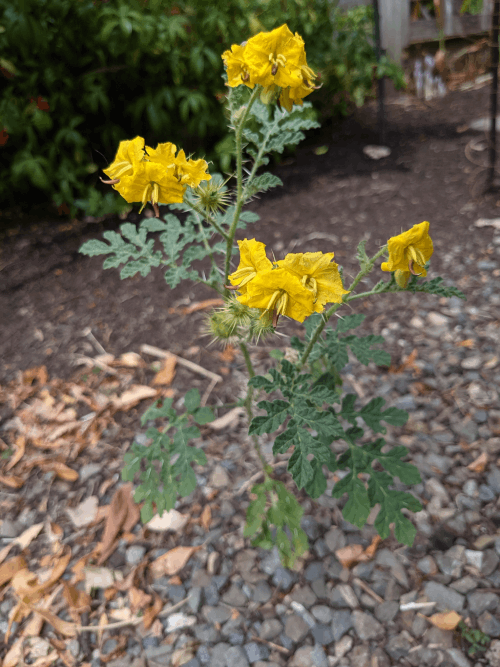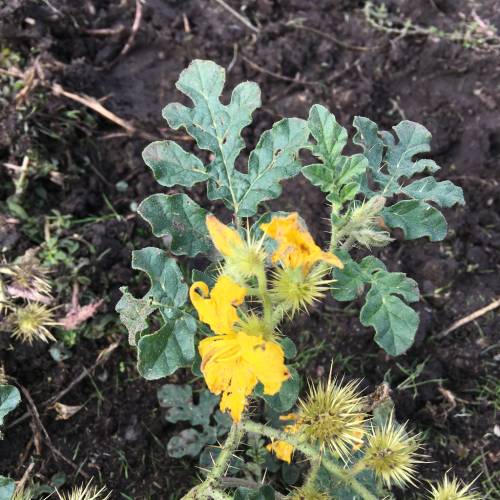Buffalobur identification and control
About this weed
Buffalobur is a regulated Class C noxious weed in King County. This means control is required in King County under the state noxious weed law.
Buffalobur is also on the Washington quarantine list and it is illegal to buy, sell or offer it for sale in the state.
Buffalobur is known as Solanum rostratum and it is in the nightshade family. It is also known as Kansas thistle and Texas thistle.

Why it’s a problem
Buffalobur can spread quickly by seed and is able to grow in a wide range of conditions. It is very aggressive in rangelands and pastures, competing with forage plants. The burs are a serious nuisance to wool producers even in the plant's native range and this spiny plant can be a real pest on a farm or in range areas.
Because buffalobur is not established in King County, we have an opportunity to stop it from spreading.
Plant description
Buffalobur is an annual (1 year life cycle) plant that has straight, sharp spines on its leaves, stems, and flowers. It grows up to 2 feet tall with multi-branched stems and deeply lobed, veined leaves up to 5 inches long.
The leaves are irregularly shaped in 5 to 7 lobes, and often are 2 to 5 lobed. They are covered in short yellow starlike hairs and the midribs, veins, and leaf stalks are spiney.
From mid-summer to the first frost, the plant produces bright yellow, 1-inch-wide flowers with 5 petals joined at the stem base. Flowers are followed by spiny calyxes or “burs” that contain seeds. The flowers bloom in late June to early August.
The seeds are almost circular, a half inch or slightly more in diameter and brown to reddish brown. They are flattened, irregularly angled with a finely pitted surface. Seeds mature July to October.
Buffalobur spreads entirely by seed, producing up to 8,500 seeds per plant. When the plant matures, its main stem breaks off and tosses in the wind, spreading the seeds. The seed-containing burs are also spread via animals, rain, and human activity. Buffalobur is self-fertile, so even a single plant can quickly create a big problem.
Although buffalobur is native to the midwestern United States, it is widely introduced elsewhere. It has been introduced to the Pacific Northwest multiple times, often as a seed contaminant in flowers, vegetables, and even birdseed.
It has a very limited distribution in King County, growing mostly in disturbed areas, roadsides, yards, and pastures. It likes sandy soil, but can also be found in dry, hard soil, and moist soils in cultivated fields.




5


Be aware of look-alike plants
Could be confused with other species in the nightshade family. Most look-alikes are not spiney. Any exceptions like the Carolina horsenettle (S. carolinense) have white-ish or purple-ish flowers. Yellow flowers, spines, and two types of stamen (stalks in the flower center) are distinctive features of buffalobur.
When in doubt, take photos and share them with us or report them on iNaturalist.
What to do if you find it
Property owners are required to control buffalobur on lands that they manage. Please notify us if you see buffalobur growing in King County. Our program staff can provide the property owner or appropriate public agency with site-specific advice on how best to remove it. We map all known locations of regulated noxious weeds such as buffalobur in order to help us and others locate new infestations in time to control them.
Control methods
We recommend using a combination of methods to control noxious weeds. In areas with few weeds, it is important to act quickly before they become harder to control. Make a long-term plan as it often takes several years to get rid of most weeds. Start in the least infested areas first and then move into more heavily infested areas.
Control should be done before flowering to prevent seed production. Protect yourself against the burs by wearing personal protective equipment such as sturdy glove, eye protection, and long sleeves and pants.
Cultural control
Maintaining healthy grass or another competitive vegetative cover will help to suppress buffalobur.
Manual control
While wearing gloves, hand pull or dig out before seed heads form making sure to cut the root at least 1 inch below ground level. This works best for small patches.
Mechanical control
Larger infestations can be controlled through close mowing, hoeing, or with manually operated tools such as brush cutters, machetes, or loppers to prevent seed production.Cut plants below ground level to prevent regrowth. Clean equipment and take care to avoid spreading seed heads to un-infested sites.
Chemical control
Stay safe when using herbicide:
- Always read the label before use.
- Wear a long-sleeved shirt, long pants, shoes, and eye protection.
- Follow state and local regulations.
Herbicides with the active ingredient dicamba and 2,4-D can be effective in controlling buffalobur and should be applied prior to flowering. Look for products containing these active ingredients under different brand names. Spot treatment using glyphosate will also control buffalobur, but this product also kills grass so don’t use in pastures or lawns. See the PNW Pest Management Handbook for the most up to date and specific method for chemical control of buffalobur.
Disposal instructions
All mature burs need to be bagged and removed so no seeds are left on site. Immature seedheads can continue to develop in cut plants. The less stem attached to the flowerhead the faster the seed head will dry out.
Noxious Weed Disposal - Washington State Noxious Weed Control Board

 Translate
Translate